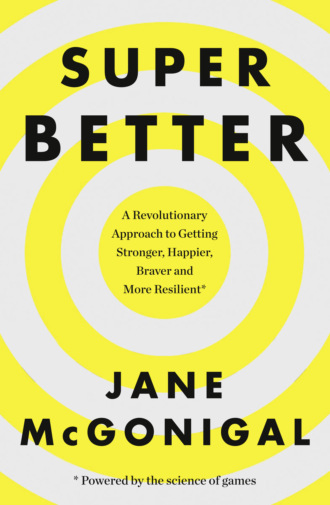
Полная версия
SuperBetter: How a gameful life can make you stronger, happier, braver and more resilient
4. Take committed action. Make small steps toward your biggest goal, every single day. Taking committed action means trying to take a step forward, even if it is difficult for you. It means always keeping your eyes on the larger goal. In games, we have a structure to do this. It’s called a “quest,” and it helps us stay focused on making progress toward the goal that matters most to us.
5. Cultivate connectedness. Try to find at least two people you feel you can ask for help, and who you can speak to honestly about your stress and challenges. In multiplayer games, we practice the art of making “allies”—people who understand the obstacles we’re facing and who have our back.
6. Find the heroic story. Look at your life and find the heroic moments. Focus on the strength you’ve shown and the meaning and purpose to your struggles. In games, heroic stories abound. We often take on the “secret identity” of heroic characters as part of the journey; their stories inspire and motivate us to try harder and become better versions of ourselves.
7. Learn the skill of benefit finding. Be aware of good outcomes that can come even from stress or challenge. In games, we have the notion of “epic wins,” or extremely positive outcomes that can arise when you least expect them, from the most unlikely or daunting circumstances.
No wonder SuperBetter works so well for so many people! Once you understand the science, it makes perfect sense. Of course a game designer like me would create a system that taps into these naturally gameful ways of thinking and acting. I didn’t know it at the time, but SuperBetter was essentially a perfect road map to post-traumatic and post-ecstatic growth. Not because I was a genius but because I was a good game designer, and all good games train us in the seven ways of thinking and acting that help us turn extreme stress and challenge into positive transformation.
These seven rules to live by make up the SuperBetter method, and they are the heart of this book:
1. Challenge yourself.
2. Collect and activate power-ups.
3. Find and battle the bad guys.
4. Seek out and complete quests.
5. Recruit your allies.
6. Adopt a secret identity.
7. Go for an epic win.
If you’re already facing a tough challenge—an illness, an injury, a loss, a personal struggle—following these rules will not only help you be more successful in dealing with the challenge; you’ll also be more likely to experience the benefits of post-traumatic growth.
If you’re not facing an extremely stressful challenge at the moment, but you still want to become stronger, happier, braver, and more resilient, just pick a meaningful and challenging goal for yourself—and then follow these rules as you try to achieve it. You will have the satisfaction of doing something extraordinary and start to unlock the benefits of post-ecstatic growth.

If I sound quite confident that you can transform your life for the better with a gameful mindset and the SuperBetter method, it’s because I am.
Since I invented SuperBetter, more than 400,000 people have played an online version of the game. We’ve recorded every power-up they’ve activated, every bad guy they’ve battled, and every quest they’ve completed—so we know what works and what doesn’t. I’ve joined forces with data scientists to analyze all the information we’ve collected from these 400,000 players over the past two years. I wanted answers to some of the same questions you might have: Who can the SuperBetter method work for? (Virtually anyone—young or old, male or female, avid game player or someone who has never played a video game in their life.) How long do you have to play by the seven rules before you start to feel stronger, happier, and braver? (Our studies show measurable improvements within two weeks and even bigger improvements at four weeks and six weeks.) And most important, do these benefits last? (As far as we know, yes. This method has existed for only a few years, but we’ve followed up with successful players at six months, a year, and when possible two years later. We found that gameful ways of thinking and acting are a skill set that, once learned, you are likely to keep practicing and benefiting from.)
I’ve waited five years to write this book because I wanted to be absolutely sure that the gameful method works. I waited for early research on the positive benefits of games to be confirmed in larger, more robust studies. I waited for scientists from a wider range of fields, including neuroscience and behavioral psychology, to weigh in with their theories on how a gameful mindset can help. Most important, I waited until I could team up with doctors and psychology researchers myself to test the SuperBetter method in rigorous studies—and I have, with a randomized, controlled trial with the University of Pennsylvania and with a clinical trial with the Ohio State University Wexner Medical Center and Cincinnati Children’s Hospital. (You’ll read about that research in “About the Science,” at the end of this book.)
Not a day has gone by in these five years that I haven’t received an email or Facebook message from someone telling me how much SuperBetter has inspired them or helped their family. I hear from people from all walks of life, like Norman J. Cannon, a commander in the air force.
I was taking command of a 2,000-person squadron in the air force and wanted to talk to them about resilience. Meanwhile, my wife had just fallen down the stairs in September 2012 and had a severe concussion. She had all the same thoughts and experiences you mentioned. I showed my wife your SuperBetter video. She cried while watching, realizing that somebody understands. I then showed the video to all 2,000 of my military and civilian employees in a commander’s call that I had. It hit home with a lot of people.
I hear from parents like Michelle T., a mom in West Virginia, who says:
My thirteen-year-old son has juvenile diabetes, and this is EXACTLY what I’ve been praying for. Our family has formed our own superhero team, and the emotional change I see in my son is glorious! I’m getting my son back! Thank you!
And I hear from patients like Jessica MacDonald, then a thirty-year-old administrative assistant from Denver who played SuperBetter while she battled multiple surgeries and hospitalization for a severe staph infection.
When you’re ill or injured, the world becomes one of can’ts. I can’t lift that because of the antibiotics IV in my arm; I can’t attend that event because I’m too tired; I can’t go to work because I’m on enough medications to kill a horse and barely know my own name. A million times a day the word can’t goes through your mind, and it murders your soul by inches. If I boil all the benefits of this game down to one thing, it is this: SuperBetter turns can’t into can. Sure, there are still things you aren’t allowed to or shouldn’t do, but you stop focusing so much on the limitations. You begin to see and celebrate your achievements.
Jessica invited her doctors and nurses to be allies, and they had a lot to say about the game, too.
The question everyone asks is “Did it help speed your recovery?” I can’t say unequivocally that I got better faster because of this game, but I will tell you what my infectious disease doctor told me. In nearly fifty years of medical practice, he said he’s come to one conclusion: patients’ attitudes overwhelmingly influence the recovery process. He told me, “I don’t know if you got better faster, but you got better better.”
It doesn’t matter if you’re a lifelong game player or you’ve never played a video game. It doesn’t matter if you prefer sports, card games, or board games to digital games. Whatever your history with games, you have the capacity to tap into your natural strengths by playing games—and you can learn to bring these gameful strengths to your real life challenges and goals.
Most people see games as nothing more than a pleasant distraction—or worse, as an addicting waste of time. But I see them differently—and not just because of my personal experience with SuperBetter. I’ve been researching the psychology of games for nearly fifteen years. I’ve studied games that decrease anxiety, alleviate depression, prevent pain, and treat post-traumatic stress disorder. I’ve analyzed games that increase willpower, boost self-esteem, improve attention skills, and strengthen family relationships. The mounting scientific evidence about games from the fields of psychology, medicine, and neuroscience has changed my mind about what games are—and what they can teach us. Games are not just a source of entertainment. They are a model for how to become the best version of ourselves.
I want you to look at games differently, too. I want you to discover the connection between the strengths you naturally express when you play games and the strengths you need to be happy, healthy, and successful in real life. To be more specific, I want you to see games as an opportunity to practice the seven life-changing skills that will make you a stronger person in every way: mentally, emotionally, physically, and socially.
You don’t have to be an avid game player to activate your gameful strengths in everyday life, but if you love or play any game regularly—golf, bridge, Scrabble, soccer, poker, Candy Crush Saga, solitaire, sudoku—you’re probably a bit more in touch with your gameful strengths already.
To lead a more gameful life, you simply have to be open to learning about the psychology of games—and be willing to experiment with new ways of thinking and acting that can help you increase your natural resilience.
The fastest way I know to get you to see games—and your own capabilities—differently is to play a game with you.
So let’s play a game together—right now.

I challenge you to complete four life-changing quests in the next five minutes.
Don’t worry, it’s easier than it sounds. I’ve watched some amazing people complete the same four quests you’re about to undertake—including Oprah Winfrey, legendary skateboarder and entrepreneur Tony Hawk, and Colonel Bat Masterson, the surgeon general for the U.S. Armed Forces. If they can do it, you can do it, too.
These are the first four quests that every SuperBetter player completes. I guarantee that if you successfully complete them all, roughly five minutes from now you will already be a stronger person—mentally, emotionally, physically, and socially. (You’ll also have a much better idea of how this book can help you unleash your gameful qualities.)
Ready to play? Let’s go!
THE GAME STARTS NOW
Here’s your first life-changing quest. I want you to complete it, right now, before you read any further.
Do not skip this first quest. I repeat: DO NOT SKIP THIS QUEST. If you skip it, you’ll be tempted to skip others—and then the game will be over before you’ve even started playing. So here we go. Your first quest—I know you can do it!

QUEST 1: Physical Resilience
Pick one:
Stand up and take three steps.
or
Make your hands into fists and hold them over your head as high as you can for five seconds.
Go!
Did you do it? Well done!
By completing this quest, you’ve just boosted your physical resilience.
Physical resilience is your body’s ability to withstand stress and heal itself. And research shows that the number-one thing people can do to boost their physical resilience is to not sit still. Whenever you sit still for more than a few minutes, your body starts to shut down at the metabolic level. This shutdown negatively impacts every aspect of your health, from your immune system to your ability to handle stress.7
Every single second you’re not sitting still, however, you’re actively improving the health of your heart, your lungs, and your brain.8 You’ll have more energy and sleep better, too—which is crucial when you’re facing a hard challenge, even if it isn’t primarily physical in nature.
So stand up for just one second. Take three steps. Throw your arms in the air. That’s all it takes. You are now physically stronger than you were thirty seconds ago.
Ready for your next quest?

QUEST 2: Mental Resilience
Pick one:
Snap your fingers exactly fifty times
or
Count backward from 100 by 7, like this: 100, 93 . . . all the way to at least 0.
Go!
All done? Good work.
By completing this quest, you’ve just increased your mental resilience.
Mental resilience is motivation, focus, and willpower—strengths that are essential to achieving any goal.
Researchers have figured out that willpower is like a muscle. It gets stronger the more you exercise it—as long as you don’t exhaust it.9 Accomplishing tiny challenges—even ones as absurd as snapping your fingers exactly fifty times or counting backward by seven—helps you exercise this muscle without wearing it out. That means you’re more likely to have the motivation and determination you need when it’s time to tackle tougher obstacles. So congratulations: you are now mentally stronger than you were a minute ago.
Let’s keep playing!

QUEST 3: Emotional Resilience
Pick one:
If you’re inside, find a window and look outside for thirty seconds. If you’re outside, find a window and look in.
or
Do a Google Image or YouTube video search for “baby [your favorite animal].”
Go!
Mission accomplished? Great!
By completing this quest, you’ve just strengthened your emotional resilience.
Emotional resilience is the ability to access positive emotions at will. It doesn’t matter if you’re stressed, or bored, or angry, or in pain—when you have emotional resilience, you can choose to feel something good instead.
Emotional resilience is a particularly important strength. Research has shown that if, on average, people experience more positive emotions than negative ones, they gain a huge range of benefits. They’re more creative at solving problems. They’re more ambitious and successful at school and at work. They’re less likely to give up when things are hard. People around them are more likely to offer help and support them in their goals.10
To achieve emotional resilience, you don’t need to eliminate negative emotions—that’s obviously impossible. You just need enough positive emotions, over the course of a day, to beat out the negative ones.
Both options in this quest are scientifically validated methods for provoking a specific positive emotion. Looking through a window provokes curiosity—the positive emotion that psychologists define as “a desire to gratify the mind with new information or objects of interest.”11 (Hopefully you saw something interesting through the window!) Meanwhile, researchers have demonstrated that looking at photos or videos of baby animals is all it takes to make virtually anyone feel the emotion of love. (Baby animal cuteness brings out our nurturing instinct!) Better yet, this quick burst of love from looking at baby animals doesn’t just feel good, it also improves attention and productivity.12
Even if you felt the curiosity or the love for only a few seconds, you just got emotionally stronger. Enjoy it.
Let’s try one more quest.

QUEST 4: Social Resilience
Pick one:
Shake or hold someone’s hand for at least six seconds.
or
Send someone you know a quick thank-you by text, email, or Facebook message.
Go!
All done? Awesome.
By completing this quest, you’ve boosted your social resilience.
Social resilience is the ability to get support from friends, family members, neighbors, and co-workers. You’re able to ask for the help you need—and you’re more likely to receive it. Social support is crucial to tackling challenges successfully. You can try to go it alone, but your odds of success are vastly improved when someone else has your back.
There are lots of ways to increase your social resilience. Touch and gratitude are two of the most effective.
Studies show that shaking or holding someone’s hand for at least six seconds increases the level of the “trust hormone,” oxytocin, in both of your bloodstreams.13 Boosted oxytocin levels make you want to help and protect each other. The more oxytocin you release together, the deeper your bond.14
Meanwhile, expressing thanks is one of the most reliable ways to cultivate good feelings and a closer connection. Gratitude is the single most important relationship-strengthening emotion because, as researchers explain, “it requires us to see how we’ve been supported and affirmed by other people.”15
So whether you just touched or thanked someone, you are now socially stronger than you were a page ago. Success!

I knew you could do it: you’ve completed four simple quests, and you’re already building up life-changing skills and abilities. You’re discovering that you are, in fact, stronger than you know; you are indeed surrounded by potential allies; and you really can become a hero to others just by tapping into your natural resilience.
Are you having fun yet? I hope so. Because my goal is to make this the most fun book you’ve ever read. You’ll complete nearly one hundred more quests before this book is through. Each one is based on a different scientific breakthrough about what makes you more resilient. And at the start of each quest, you’ll see one of these four icons to let you know if you’re building primarily physical, mental, emotional, or social resilience:

I promise you these quests will make you feel more confident, more in control, and more optimistic about all your real-life challenges. (As with any good game, these quests will get a little bit trickier the further you go!)
Seeking out and completing quests is just one of the seven gameful skills that will help you become stronger, happier, and braver in everyday life. Now that you’ve gotten a taste of what it feels like to adopt a gameful mindset, let me tell you a little bit more about what you can expect from this book.
I won’t ask you to start leading a more gameful life until you’re absolutely convinced of the ability of games to solve real problems and change real lives. So in Part 1, “Why Games Make Us Superbetter,” we’ll start with an overview of the evidence on games. What strengths do they tap into, and what psychological benefits do they bring? We’ll look at games that increase motivation and willpower, that block the feeling of physical pain more powerfully than morphine, that help you overcome anxiety and depression, that can change your eating habits, develop your compassion for others, and help you forge stronger, happier relationships with friends and family. Most of the games we discuss in Part 1 are readily available for you to play on your phone or your computer as a way to practice and understand your gameful strengths better. However, even if you decide never to play any of these games, Part 1 will give you a solid foundation to understand what it means to be gameful. You will know exactly what it takes to tap into your three most important challenge-facing, problem-solving powers: your abilities to control your attention, to make allies and get support, and to motivate yourself to do what’s important, even when it’s difficult for you. We’ll finish by exploring the research on why some game players are better able than others to bring these powers from their favorite games into their real lives.
Part 1 is full of gameful quests for you to complete, just like the ones in this introduction—so you’ll have plenty of opportunity to play and get stronger with every page.
In Part 2, “How to Be Gameful,” we’ll talk about your life. Now that you understand your strengths, what is the best way to harness them in everyday life? We’ll go in depth with each of the seven gameful skills that can help you tackle real-life challenges with more courage, creativity, and determination. I’ll give you seven simple rules to follow to practice each of these skills in daily life. This is the SuperBetter method, and it’s designed to make it easy for you to lead a more gameful life—whether or not you have the time to play games.
In Part 2, you’ll meet people who have used the SuperBetter method to grow stronger, healthier, and happier in the face of challenges like anxiety, depression, chronic pain, and PTSD. You will hear stories from people who have adopted a gameful mindset to find a better job, have a more satisfying love life, run a marathon, start their own company, and simply enjoy life more. And because everything in this book is grounded in research, you will discover the science behind these success stories—more than two hundred studies from the fields of psychology, medicine, and neuroscience that explain exactly why living by these seven gameful rules builds mental, emotional, physical, and social strengths.
If you’re facing a major challenge in your life, and you want to start using the SuperBetter method right now, you can skip directly to Part 2. Come back to Part 1 whenever you want. (I think that once you see for yourself how well SuperBetter works, you’ll be even more curious to understand the science behind it!)
Part 3, “Adventures,” brings it all together with three SuperBetter journeys I’ve created so that you can continue practicing your new gameful skills. Each journey is full of targeted power-ups, bad guys, and quests to help you achieve a major resilience breakthrough. On the “Love Connection” adventure, you’ll build your social resilience with ten quests designed to help you find love in the most surprising ways and places. In “Ninja Body Transformation,” you’ll learn twenty-one sneaky ways to increase your physical resilience. And on your final adventure, you’ll discover what it means to be “Time Rich”—the feeling that you have abundant free time to spend on all the things that matter most to you. Getting time rich is an excellent way to build your emotional and mental resilience.
Taken together, these three adventures contain just enough quests for you to keep playing SuperBetter for six weeks. That’s an important number—because six weeks is exactly how long participants followed the SuperBetter rules in our clinical trial and randomized controlled study. In those cases, playing SuperBetter for six weeks resulted in significantly better mood, stronger social support, more optimism, less depression and anxiety, and higher self-confidence. If you complete all three of these adventures—by tackling just one quest a day—you’ll have achieved a full, life-changing dose of the game.
Together, the stories and the science in this book will reveal how adopting a gameful mindset can change your life for the better. They will not only change what you think games are capable of. They will change what you think you are capable of.




